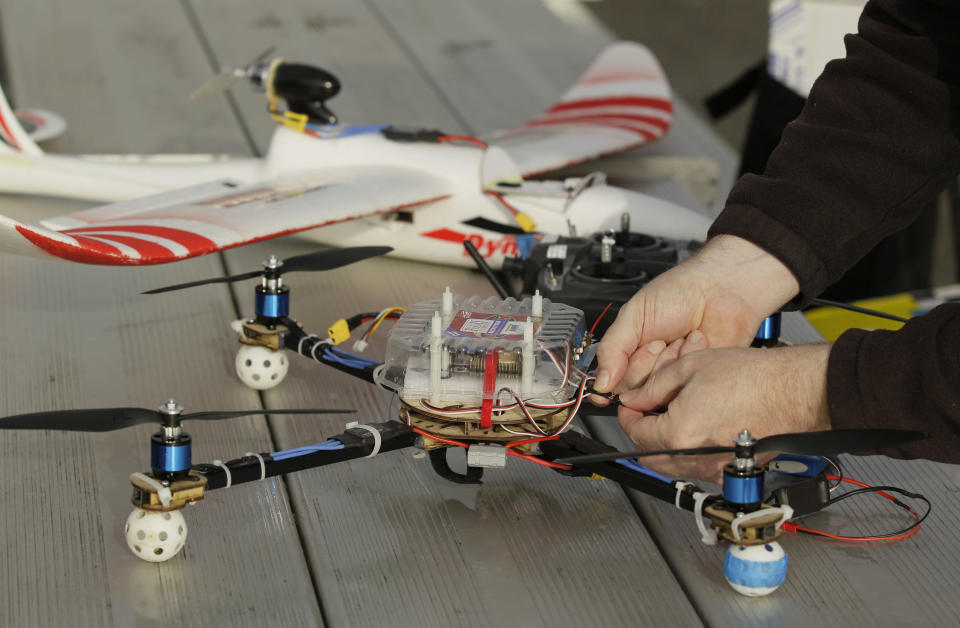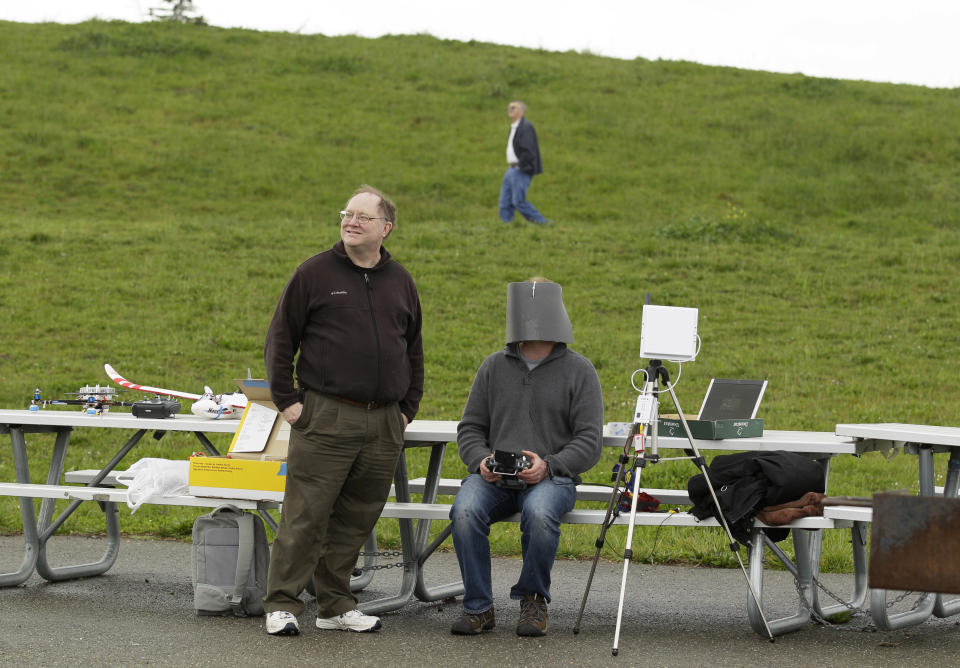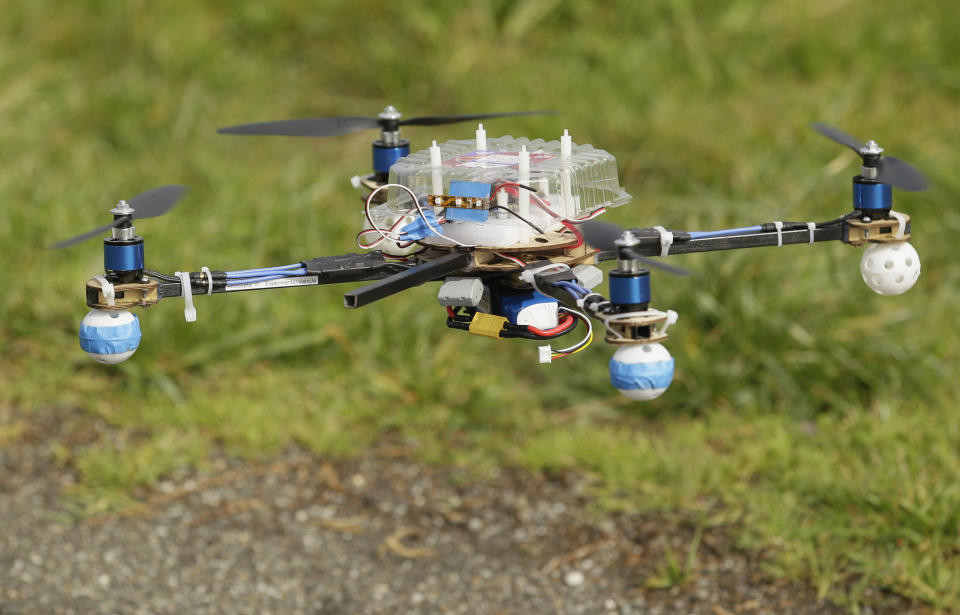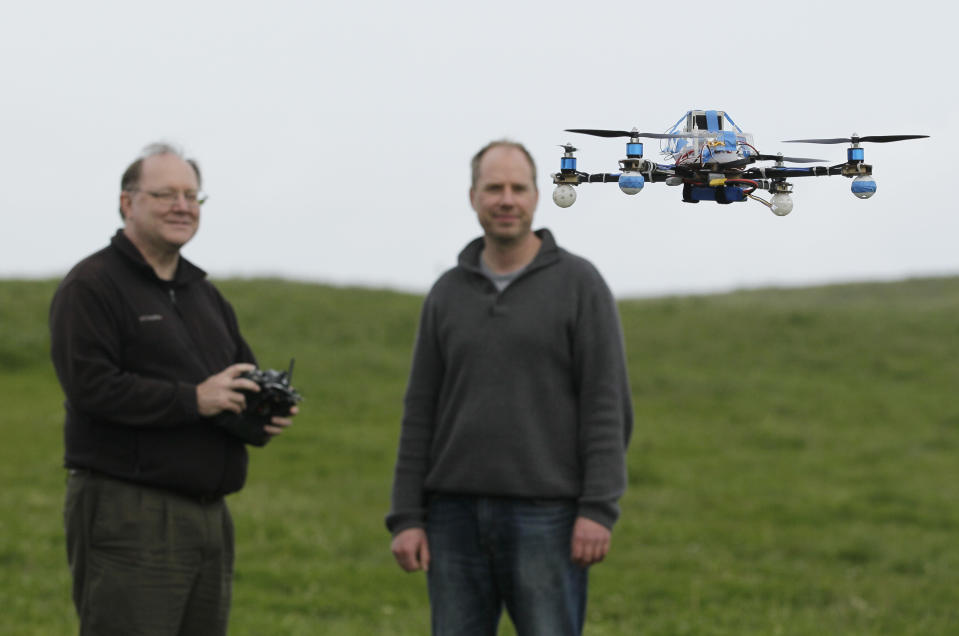Drones coming to a sky near you as interest surges
BERKELEY, Calif. (AP) — Sharp-eyed dog walkers along the San Francisco Bay waterfront may have spotted a strange-looking plane zipping overhead recently that that looked strikingly like the U.S. stealth drone captured by Iran in December.
A few key differences: The flying wing seen over Berkeley is a fraction of the size of the CIA's waylaid aircraft. And it's made of plastic foam. But in some ways it's just like a real spy plane.
The 4 1/2-foot-wide aircraft, built by software engineers Mark Harrison and Andreas Oesterer in their spare time, can fly itself to specified GPS coordinates and altitudes without any help from a pilot on the ground. A tiny video camera mounted on the front can send a live video feed to a set of goggles for the drone's view of the world below.
"It's just like flying without all the trouble of having to be up in the air," Harrison said.
Thousands of hobbyists are taking part in what has become a global do-it-yourself drone subculture, a pastime that's thriving as the Federal Aviation Administration seeks to make the skies friendlier to unmanned aircraft of all sizes.
The use of drones in the U.S. by law enforcement and other government agencies has privacy advocates on edge. At the same time, some DIY drone flyers believe the ease of sending cheap pilotless planes and choppers airborne gives citizens a powerful tool for keeping public servants on the ground honest.
Drones are the signature weapon of U.S. wars in the 21st century. Just as Humvees became a presence on U.S. highways in the 1990s after the first war with Iraq, interest in non-military uses of drones from policing to farming is rising.
Government agencies currently need FAA permission on a case-by-case basis to fly drones domestically. Commercial use is banned except for a small number of waivers for companies building experimental aircraft. But lawmakers have instructed the agency to allow civilian use of drones in U.S. airspace by September 2015. The FAA is expected to take the first step this year by proposing rules that would permit limited use of small commercial drones.
Whether a border patrol drone the size of a single-engine passenger plane or a four-rotor police "quadcopter" equipped with gear to intercept cell phone signals, the increasing ease of aerial surveillance seems destined to be put to a constitutional test over privacy.
"Our concern is with all of the drones," said Jennifer Lynch, a staff attorney with the Electronic Frontier Foundation. Small aircraft are hard to see, and large drones can fly high enough to stay out of sight, she said. "I think they all pose different levels of privacy risk."
Lynch has sued the FAA for a list of the 300 waivers it has issued to allow drone use in the U.S. At the same time, she said drones in the hands of average citizens could have important uses.
Among the groups seeking to take advantage of the steep drop in price of drone technology are journalists who want to attach cameras to aircraft the size of small pizzas and that cost as much to buy — about $400 — as a one-hour helicopter rental for a photographer.
In the San Francisco Bay area, Occupy Wall Street activists built the so-called Occucopter designed to monitor police action against protesters from the sky.
In Idaho, wildlife biologists started using a drone for counting fish nets after a helicopter crash killed two colleagues and a pilot.
And researchers are developing techniques to use drones equipped with infrared sensors to detect patches of dry ground in orchards.
Hobbyists say drone prices have been driven down sharply even in the past two or three years mainly by the surge in popularity of smartphones. The chips smartphones use to determine whether they're being held vertically or horizontally or to locate themselves on a map are the same ones drones use to keep themselves flying straight, level and in the right direction.
The supply of such chips has spiked along with the use of smartphones, sending prices lower.
"Today if you have an iPhone or an Android, you basically have an autopilot in your pocket. You're just running the wrong app," said Chris Anderson, editor-in-chief of Wired magazine and founder of DIY Drones, an online community and company that sells drone kits and parts.
Anderson started DIY Drones in 2007 after spending the weekend building an electronic Lego robot and trying to fly a radio-controlled plane with his kids. The robot didn't impress the kids on its own, and the plane was hard to fly, Anderson said. So the family used the Legos to build a primitive autopilot and attached it to the plane. The kids thought it was cool for a few weeks, but Anderson became obsessed.
Anderson said safety is a top consideration of his group, and he supports strict observance of the FAA regulations developed in the 1970s to cover the amateur use of radio-controlled planes, which also apply to today's DIY drones. Those rules include restricting their altitude to 400 feet, requiring them to always be in view of their controller on the ground and prohibiting them from being flown over built-up areas.
That last rule reportedly led to trouble for some Los Angeles real estate agents, who were warned by police to stop using drones to take photos and video of homes for sale, according to the Los Angeles Times.
In Berkeley, Harrison and Oesterer spent more time tweaking wires and software than their drones spent in the air. Part of the reason was battery power: Their drones rely on the latest in lightweight laptop batteries to stay aloft but suck significantly more power. Still, both say would-be pilots don't need degrees in computer science or electrical engineering to send drones skyward.
Said Oesterer: "It's getting really close to plug-and-fly."
___
Online:
DIY Drones: http://www.diydrones.com
EastBay RC: http://eastbay-rc.com
___
Follow Marcus Wohlsen on Twitter: http://twitter.com/marcuswohlsen





